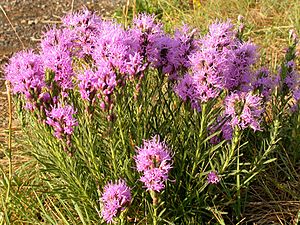Dotted gayfeather facts for kids
Quick facts for kids Dotted gayfeather |
|
|---|---|
 |
|
| Conservation status | |
| Scientific classification |
The Liatris punctata is a beautiful flowering plant. People often call it the dotted gayfeather or dotted blazingstar. It belongs to the aster family, just like sunflowers! This plant grows naturally in North America. You can find it across the plains of central Canada, the central United States, and northern Mexico.
Contents
What is Dotted Gayfeather?
The dotted gayfeather is a plant that lives for many years. It is known as a perennial herb. This plant can grow one or more straight stems. These stems usually reach about 14 to 85 centimeters (about 6 inches to 2.8 feet) tall.
How It Grows
This plant has a very special root system. It grows a thick taproot that can go very deep. This root can reach 1.3 to 5 meters (about 4 to 16 feet) into the ground! This deep root helps the plant find water. It also helps it survive dry times. The taproot also grows rhizomes. These are like underground stems that can sprout new plants.
The flowers of the dotted gayfeather grow in a spike shape. This means they are arranged closely along a stem. Each spike has several flower heads. These heads are usually purple, but sometimes they can be white. After the flowers bloom, they produce a fruit called an achene. This achene has a long, feathery pappus on top. This pappus helps the seeds float away in the wind.
Reproduction and Life Cycle
The dotted gayfeather can make new plants in two ways. It can reproduce sexually by making seeds. It can also reproduce vegetatively. This means new plants can sprout from its underground rhizomes. This plant grows slowly but lives a long time. Some dotted gayfeathers are thought to be over 35 years old!
Where Dotted Gayfeather Lives
You can find this plant from Alberta to Manitoba in Canada. It also grows in most of the central United States. Its home extends all the way into Mexico.
There are three main types, or varieties, of this plant:
- var. punctata: This type is found in the western areas.
- var. nebraskana: This type is more common in the east.
- var. mexicana: This type grows in Oklahoma and Texas.
Its Habitat
The dotted gayfeather can live in many different places. It grows in ponderosa pine forests and sagebrush areas. You can also find it in chaparral and pinyon-juniper woodland. It loves many kinds of grassland and prairie habitats too.
Because of its deep roots, this plant can handle drought well. This means it can survive when there isn't much rain. It is also good at surviving fires. After a fire, it can grow back from its rhizomes. Its seeds can also spread easily to areas where fire has cleared the ground.
On plains and prairies, it grows with many types of grasses. These include Scribner's panic grass (Panicum scribnerianum) and tumble grass (Schedonnardus paniculatus). It also grows with other wildflowers. Some of these are heath aster (Symphyotrichum ericoides), tick-trefoil (Desmodium sessilifolium), and oldfield goldenrod (Solidago nemoralis). The dotted gayfeather is also a host plant for the hemiparasitic wholeleaf Indian paintbrush (Castilleja integra).
Animal Friends and Uses
Many animals enjoy eating the dotted gayfeather. Livestock like cows and horses eat it. Wild animals such as elk, white-tailed deer, and pronghorn also like it.
Its nectar is a favorite food for butterflies and moths, called lepidopterans. A rare butterfly called the Pawnee montane skipper (Hesperia leonardus montana) especially loves this plant. This butterfly is often found wherever the dotted gayfeather grows. Long ago, Native Americans would eat the roots and leaves of this plant.
This plant is also very useful for restoring prairie habitats. It helps bring back the natural plants of the prairie. People also use it as an ornamental plant in gardens because it is so pretty.


